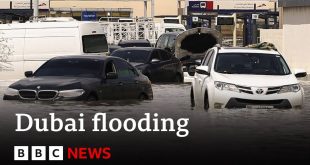
On the banks of the Patapsco river, hundreds of people from across Baltimore gather in the early evening sun.
Most are capturing photographs with their mobile phones and struggling to comprehend the sight before them. The Francis Scott Key bridge, a fixture of this city for half a century, had been obliterated in less than ten seconds.
Throughout the day, they had observed the images on television and witnessed the CCTV footage of the cargo ship colliding with one of the bridge’s support pillars, causing the entire structure to collapse almost instantly. Yet, many felt compelled to witness the aftermath firsthand.
“It’s surreal,” remarked one woman, “I genuinely cannot believe that it’s true, that it’s vanished.”
Many residents along the river had been roused by the sound of the impact just before 1:30 am. Jim Wood’s house overlooks the Key Bridge.
“The house trembled slightly,” he recounted, “initially, I mistook it for a sonic boom from an aircraft, I’ve never heard a noise quite like it, it endured for six to ten seconds, and then, it was simply indescribable.”
In the distance, a rib boat with flashing red lights encircled the wreckage of the container ship, while a rescue helicopter hovered above. However, as night descended, 18 hours following the collapse, any hope of finding survivors was officially extinguished.
Authorities declared it was no longer a search and rescue operation. Specialist divers are now tasked with retrieving the bodies of the six individuals still unaccounted for, all of whom were working overnight on the bridge to mend potholes.
However, with hazardous debris in the water and shifting tides, completion could be protracted.
Among the missing is Miguel Luna from El Salvador. At his residence, a family member conveyed their anguish as they awaited updates.
Several were escorted by police to a Baltimore location where they could unite with other families of the missing. All of the unaccounted-for individuals were employed by Brawner Builders.
At a nearby petrol station, their colleague, Jose Campos, donning an orange hat and a hoodie bearing the Brawner Builders insignia, waits anxiously for news.
“My friends were on duty there, it’s an extremely difficult day,” he shared. “My supervisor phoned me in the morning and informed me they had rescued one of my colleagues, but he’s in a coma.
“I never envisioned such a horrific event could occur. The pathway where the boat navigates was deemed a safe zone.”
The vessel had departed Baltimore harbour at 1:04 am and was less than thirty minutes into a 27-day voyage to Sri Lanka when it collided with the bridge.
Crew members aboard the ship had issued a distress call moments before impact, indicating they had lost power and were heading towards the bridge.
Officials on either side of the bridge purportedly halted traffic, potentially averting an even graver catastrophe.
“By managing to prevent cars from traversing the bridge, these individuals are heroes. They saved lives last night,” affirmed Maryland governor, Wes Moore.
Some structural engineering experts contended that the size and weight of the cargo ship, combined with its point of impact on the bridge, rendered a total collapse inevitable.
I queried the governor if he concurred with this assessment. “We’re still in the process of investigating exactly what transpired,” he responded, “so we lack further details regarding whether or not it was inevitable, but the bridge was indeed fully compliant with regulations.”
While President Joe Biden vowed to “mobilise every resource” to reopen the port and reconstruct the bridge “as swiftly as humanly possible,” Governor Moore acknowledged it would be a formidable and lengthy endeavour.
“This will be a prolonged undertaking,” he acknowledged. “We will reconstruct in a manner that honours the memory of those affected by this tragedy, and also pays tribute to the community it serves.”
The residents of Baltimore persist in visiting the prime vantage point in the city to survey the remnants of the bridge. There’s an element of macabre fascination, but also a sense that for many, it signifies the conclusion of an era and an utter disbelief that the bridge has ceased to exist.
 Wortley Today The latest headlines from the UK
Wortley Today The latest headlines from the UK




